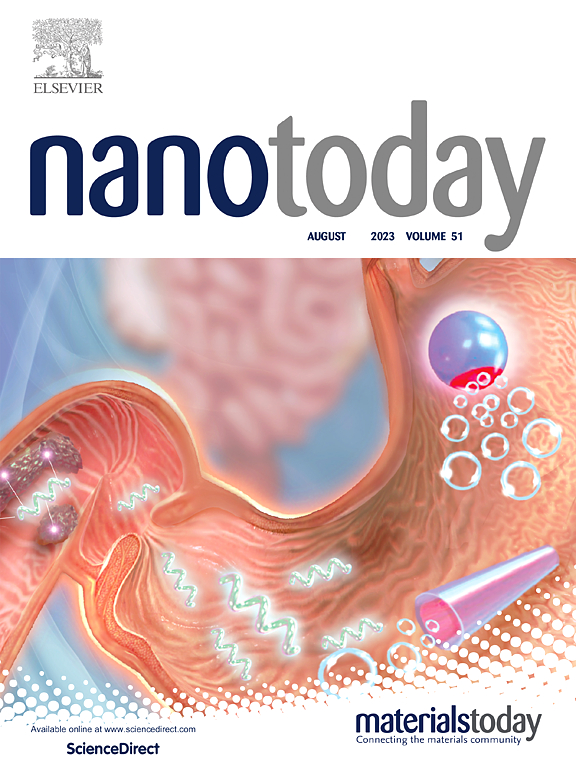Scalable production and functionalization of TMD nanosheets for bioinspired, ultrastrong, repeatable fire warning nanopapers
IF 13.2
1区 材料科学
Q1 CHEMISTRY, MULTIDISCIPLINARY
引用次数: 0
Abstract
Emerging smart fire alarm sensors (FAS) are crucial for monitoring fire hazards and have garnered increasing attention in fire safety field. However, developing low-cost yet high-performance FAS materials with mechanical flexibility, environmental tolerance, flame retardancy, and reliable fire warning capabilities via a simple and sustainable approach remains a major challenge. Here, we report a simple yet effective tannic acid (TA)-assisted mechanochemical exfoliation method for producing few-layer modified molybdenum disulfide (TA-MoS2) nanosheets with excellent water dispersibility and long-term storage stability. Besides, the method's universality was further validated with other transition metal dichalcogenides (TMDs), including MoSe2, WSe2, and WS2. By integrating one-dimensional (1D) phosphorylated-cellulose nanofibrils (P-CNFs) with two-dimensional (2D) TA-MoS2 nanosheets, we fabricated P-CNFs/TA-MoS2 nanocomposite papers with a hierarchical biomimetic structure. The optimized paper demonstrated exceptional mechanical flexibility and strength (∼118 MPa), solvent resistance, and flame retardancy. Notably, it achieved a rapid fire alarm response (<3 s) and reliable cyclic fire warning performance. These outstanding properties make such MoS2-based hybrid network a promising candidate for FAS materials in fire safety and protection. Furthermore, the TA-TMDs synthesized via this strategy hold significant potential in electronics, biomedicine, catalysis, and energy sectors.
可扩展的生产和功能化TMD纳米片的生物启发,超强,可重复的火灾报警纳米纸
新兴的智能火灾报警传感器(FAS)是监测火灾危险的关键,在消防安全领域受到越来越多的关注。然而,通过简单和可持续的方法开发具有机械灵活性、环境耐受性、阻燃性和可靠火灾预警能力的低成本高性能FAS材料仍然是一个主要挑战。在这里,我们报告了一种简单而有效的单宁酸(TA)辅助机械化学剥离方法,用于生产具有优异水分散性和长期储存稳定性的少层改性二硫化钼(TA- mos2)纳米片。此外,用MoSe2、WSe2、WS2等其他过渡金属二硫族化合物进一步验证了该方法的通用性。通过将一维(1D)磷酸化纤维素纳米原纤维(P-CNFs)与二维(2D) TA-MoS2纳米片相结合,制备了具有分层仿生结构的P-CNFs/TA-MoS2纳米复合纸。优化后的纸张具有优异的机械柔韧性和强度(~ 118 MPa),耐溶剂性和阻燃性。值得注意的是,它实现了快速的火灾报警响应(<3 s)和可靠的循环火灾报警性能。这些突出的性能使这种基于mos2的混合网络成为消防安全和防护领域FAS材料的有希望的候选者。此外,通过该策略合成的ta - tmd在电子、生物医药、催化和能源领域具有巨大的潜力。
本文章由计算机程序翻译,如有差异,请以英文原文为准。
求助全文
约1分钟内获得全文
求助全文
来源期刊

Nano Today
工程技术-材料科学:综合
CiteScore
21.50
自引率
3.40%
发文量
305
审稿时长
40 days
期刊介绍:
Nano Today is a journal dedicated to publishing influential and innovative work in the field of nanoscience and technology. It covers a wide range of subject areas including biomaterials, materials chemistry, materials science, chemistry, bioengineering, biochemistry, genetics and molecular biology, engineering, and nanotechnology. The journal considers articles that inform readers about the latest research, breakthroughs, and topical issues in these fields. It provides comprehensive coverage through a mixture of peer-reviewed articles, research news, and information on key developments. Nano Today is abstracted and indexed in Science Citation Index, Ei Compendex, Embase, Scopus, and INSPEC.
 求助内容:
求助内容: 应助结果提醒方式:
应助结果提醒方式:


